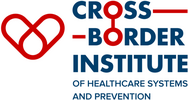
CHARE-GD II Subproject 1: Establishing a Health and Contextual Data Inventory to Facilitate Interdisciplinary Cross-Border Research
CHARE-GD II Subproject 1: Establishing a Health and Contextual Data Inventory to Facilitate Interdisciplinary Cross-Border Research
For other languages, see Nederlands and Deutsch.

Project background
Cross-border health research is heavily reliant on comparable data sources to analyse the differences and similarities between both sides of the border. As a result, Subproject 1 of the CHARE-GD II aims to establish a Cross-border Health Data Inventory which will facilitate interdisciplinary cross-border research. This inventory will provide an overview of available health and contextual data sources covering the Ems-Dollard region and their suitability, particularly for comparative research purposes.
Population health differences in cross-border regions within the European Union and Schengen area: a protocol for a scoping review
European integration and the abolition of border controls within the European Union (EU) have improved the living conditions and health of the population over the last thirty years. Among other things, this has led to economic convergence, and increased cultural exchange and cooperation in the healthcare sector. However, despite these positive developments, socio-spatial health inequalities still exist within and between Member States. While the causes of health inequalities at the national and regional levels have been studied in detail, little attention has been paid to cross-border regions. However, such regions offer unique opportunities to analyse the impact of European integration on the health of the population. On the one hand, the inhabitants often share a common historical and cultural background, on the other hand, they are exposed to two different healthcare systems.
Aim of the study
This study aims to analyse how health indicators have changed over time in cross-border areas of the EU using existing research. It also aims to identify the types of data sources used in the respective studies and research gaps in the existing literature.
Method
In this study, we will conduct a comprehensive literature review. We will follow the guidelines of the Joana Briggs Institute. Using these guidelines, we will define the inclusion and exclusion criteria to determine which studies will be included and discussed in our literature search. A comprehensive search strategy is conducted in several literature databases as well as on the websites of international governmental organisations. The results will be collated in a table and accompanied by a narrative summary.
Implications
Understanding the health situation in cross-border regions is essential for promoting economic and social unity within the EU. This study can help to identify knowledge gaps and develop policies to address health inequalities between EU Member States. It contributes to the ongoing discussions on the harmonisation of healthcare in the EU by highlighting the impact of European integration on cross-border regions.
Would you like to know more?
You can find this study here: https://bmjopen.bmj.com/content/bmjopen/13/8/e068571.full.pdf
Stroisch, S., Angelini, V., Schnettler, S., & Vogt, T. (2023). Population health differences in cross-border regions within the European Union and Schengen area: a protocol for a scoping review. BMJ open, 13(8), e068571.


